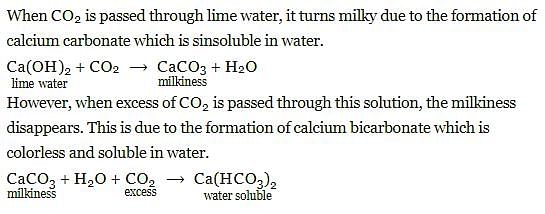Class 10 Exam > Class 10 Tests > Test: Introduction to Acids & Bases - Class 10 MCQ
Test: Introduction to Acids & Bases - Class 10 MCQ
Test Description
20 Questions MCQ Test - Test: Introduction to Acids & Bases
Test: Introduction to Acids & Bases for Class 10 2024 is part of Class 10 preparation. The Test: Introduction to Acids & Bases questions and answers have been prepared
according to the Class 10 exam syllabus.The Test: Introduction to Acids & Bases MCQs are made for Class 10 2024 Exam.
Find important definitions, questions, notes, meanings, examples, exercises, MCQs and online tests for Test: Introduction to Acids & Bases below.
Solutions of Test: Introduction to Acids & Bases questions in English are available as part of our course for Class 10 & Test: Introduction to Acids & Bases solutions in
Hindi for Class 10 course.
Download more important topics, notes, lectures and mock test series for Class 10 Exam by signing up for free. Attempt Test: Introduction to Acids & Bases | 20 questions in 15 minutes | Mock test for Class 10 preparation | Free important questions MCQ to study for Class 10 Exam | Download free PDF with solutions
Detailed Solution for Test: Introduction to Acids & Bases - Question 1
Test: Introduction to Acids & Bases - Question 2
How do acids interact with metal carbonates and metal hydrogencarbonates?
Detailed Solution for Test: Introduction to Acids & Bases - Question 2
| 1 Crore+ students have signed up on EduRev. Have you? Download the App |
Test: Introduction to Acids & Bases - Question 3
What happens when excess carbon dioxide is passed through lime water?
Detailed Solution for Test: Introduction to Acids & Bases - Question 3
Test: Introduction to Acids & Bases - Question 4
What is the general outcome when bases react with metals?
Detailed Solution for Test: Introduction to Acids & Bases - Question 4
Test: Introduction to Acids & Bases - Question 5
What is the result of a neutralization reaction between a strong acid and a strong base?
Detailed Solution for Test: Introduction to Acids & Bases - Question 5
Test: Introduction to Acids & Bases - Question 6
In a reaction between a weak acid and a weak base, what type of salt is typically formed?
Detailed Solution for Test: Introduction to Acids & Bases - Question 6
Test: Introduction to Acids & Bases - Question 7
When a strong acid reacts with a weak base, what is the nature of the resulting solution?
Detailed Solution for Test: Introduction to Acids & Bases - Question 7
Test: Introduction to Acids & Bases - Question 8
When a metallic oxide reacts with an acid, what is typically produced?
Detailed Solution for Test: Introduction to Acids & Bases - Question 8
Test: Introduction to Acids & Bases - Question 9
What determines the pH of the solution after a neutralization reaction between an acid and a base?
Detailed Solution for Test: Introduction to Acids & Bases - Question 9
Detailed Solution for Test: Introduction to Acids & Bases - Question 10
Test: Introduction to Acids & Bases - Question 11
When a non-metallic oxide reacts with a base, what is typically formed?
Detailed Solution for Test: Introduction to Acids & Bases - Question 11
Test: Introduction to Acids & Bases - Question 12
What is the general chemical equation for the reaction between an acid and a metal hydrogen carbonate?
Detailed Solution for Test: Introduction to Acids & Bases - Question 12
Test: Introduction to Acids & Bases - Question 13
What property do acids and bases share that allows them to conduct electricity when dissolved in water?
Detailed Solution for Test: Introduction to Acids & Bases - Question 13
Test: Introduction to Acids & Bases - Question 14
In a neutralization reaction between an acid and a base, what are the products formed?
Detailed Solution for Test: Introduction to Acids & Bases - Question 14
Test: Introduction to Acids & Bases - Question 15
What happens to acids when dissolved in water in terms of the ions they produce?
Detailed Solution for Test: Introduction to Acids & Bases - Question 15
Test: Introduction to Acids & Bases - Question 16
How is the strength of an acid or base determined based on its behavior in water?
Detailed Solution for Test: Introduction to Acids & Bases - Question 16
Detailed Solution for Test: Introduction to Acids & Bases - Question 17
Test: Introduction to Acids & Bases - Question 18
What distinguishes strong acids from weak acids?
Detailed Solution for Test: Introduction to Acids & Bases - Question 18
Test: Introduction to Acids & Bases - Question 19
Which color does an acid turn blue litmus paper?
Detailed Solution for Test: Introduction to Acids & Bases - Question 19
Test: Introduction to Acids & Bases - Question 20
What taste is commonly associated with acids?
Detailed Solution for Test: Introduction to Acids & Bases - Question 20
Information about Test: Introduction to Acids & Bases Page
In this test you can find the Exam questions for Test: Introduction to Acids & Bases solved & explained in the simplest way possible.
Besides giving Questions and answers for Test: Introduction to Acids & Bases, EduRev gives you an ample number of Online tests for practice
Download as PDF


















